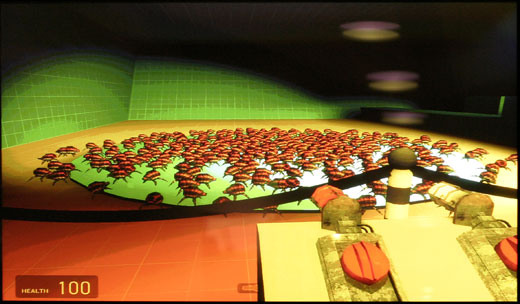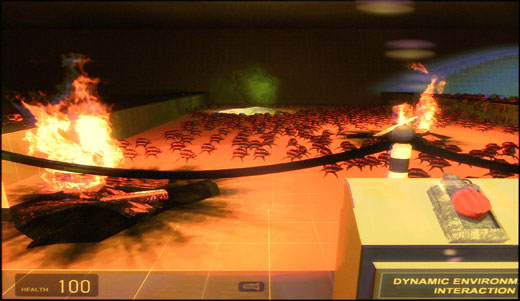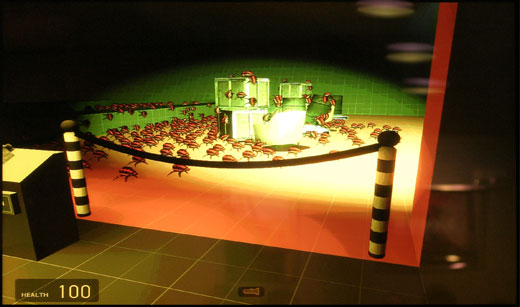Valve Hardware Day 2006 - Multithreaded Edition
by Jarred Walton on November 7, 2006 6:00 AM EST- Posted in
- Trade Shows
Gaming's Future, Continued
So what can be done besides making a world look better? One of the big buzzwords in the gaming industry right now is physics. Practically every new game title seems to be touting amazing new physics effects. Perhaps modern physics are more accurate, but having moderate amounts of physics in a gaming engine is nothing new. Games over a decade ago allowed you to do such things as pick up a stone and throw it (Ultima Underworld), or shoot a bow and have the arrow drop with distance. Even if the calculations were crude, that would still count as having "physics" in a game. Of course, there's a big difference in the amount of physics present in Half-Life and those present in Half-Life 2, and most people would agree that the Half-Life 2 was a better experience due to the improved interaction with the environment.
Going forward, physics can only become more important. One of the holy grails of gaming is still the creation of a world that has a fully destructible environment. Why do you need to find a stupid key to get through a wooden door when you're carrying a rocket launcher? Why can't you blow up the side of the building and watch the entire structure fall to the ground, perhaps taking out any enemies that were inside? How about the magical fence that's four inches too tall to jump over - why not just break it down instead of going around? It's true that various games have made attempts in this direction, but it's still safe to say that no one has yet created a gaming environment that allows you to demolish everything as you could in the real world (within reason). Gameplay still needs to play a role in what is allowed, but the more the possibilities for what can be done are increased, the more likely we are to see revolutionary gameplay.
Going along with physics and game world interactions, Valve spoke about the optimizations they've made in a structure called the spatial partition. The spatial partition is essentially a representation of the game world, and it is queried constantly to determine how objects interact. From what we could gather, it is used to allow rough approximations to take place where it makes sense, and it also helps determine where more complex (and accurate) mathematical calculations should be performed. One of the problems traditionally associated with multithreaded programming has been locking access to certain data structures in order to keep the world in a consistent state. For the spatial partition, the vast majority of the accesses are read operations that can occur concurrently, and Valve was able to use lock-free and wait-free algorithms in order to greatly improve performance. A read/write log is used to make sure the return values are correct, and Valve emphasized that the lock-free algorithms were a huge design win when it came to multithreading.
Another big area that can stand to see a lot of improvement is artificial intelligence. Often times, AI has a tacked on feel in current games. You want your adversaries to behave somewhat realistically, but you don't want the game to spend so much computational power figuring out what they should do that everything crawls to a slow. It's one thing to wait a few seconds (or more) for your opponent to make a move in a chess match; it's a completely different story in an action game being rendered at 60 frames per second. Valve discussed the possibilities for having a greater number of simplistic AI routines running, along with a few more sophisticated AI routines (i.e. Alyx in Episode One).



They had some demonstrations of swarms of creatures interacting more realistically with the environment, doing things like avoiding dangerous areas, toppling furniture, swarming opponents, etc. (The action was more impressive than the above screenshots might indicate.) The number of creatures could also be increased depending on CPU power (number of cores as well as clock speed), so where a Core 2 Quad might be able to handle 500 creatures, a single core Pentium 4 could start to choke on only 80 or so creatures.
In the past, getting other creatures in the game world to behave even remotely realistically was sufficient -- "Look, he got behind a rock to get shelter!" -- but there's so much more that can be done. With more computational power available to solve AI problems, we can only hope that more companies will decide to spend the time on improving their AI routines. Certainly, without having spare processor cycles, it is difficult to imagine any action games spending as much time on artificial intelligence as they spend on graphics.
There are a few less important types of AI that could be added as well. One of these is called "Out of Band AI" -- these are AI routines that are independent of the core AI. An example that was given would be a Half-Life 2 scene where Dr. Kleiner is playing chess. They could actually have a chess algorithm running in the background using spare CPU cycles. Useful? Perhaps not that example, unless you're really into chess, but these are all tools to create a more immersive game world, and there is almost certainly someone out there that can come up with more interesting applications of such concepts.
So what can be done besides making a world look better? One of the big buzzwords in the gaming industry right now is physics. Practically every new game title seems to be touting amazing new physics effects. Perhaps modern physics are more accurate, but having moderate amounts of physics in a gaming engine is nothing new. Games over a decade ago allowed you to do such things as pick up a stone and throw it (Ultima Underworld), or shoot a bow and have the arrow drop with distance. Even if the calculations were crude, that would still count as having "physics" in a game. Of course, there's a big difference in the amount of physics present in Half-Life and those present in Half-Life 2, and most people would agree that the Half-Life 2 was a better experience due to the improved interaction with the environment.
Going forward, physics can only become more important. One of the holy grails of gaming is still the creation of a world that has a fully destructible environment. Why do you need to find a stupid key to get through a wooden door when you're carrying a rocket launcher? Why can't you blow up the side of the building and watch the entire structure fall to the ground, perhaps taking out any enemies that were inside? How about the magical fence that's four inches too tall to jump over - why not just break it down instead of going around? It's true that various games have made attempts in this direction, but it's still safe to say that no one has yet created a gaming environment that allows you to demolish everything as you could in the real world (within reason). Gameplay still needs to play a role in what is allowed, but the more the possibilities for what can be done are increased, the more likely we are to see revolutionary gameplay.
Going along with physics and game world interactions, Valve spoke about the optimizations they've made in a structure called the spatial partition. The spatial partition is essentially a representation of the game world, and it is queried constantly to determine how objects interact. From what we could gather, it is used to allow rough approximations to take place where it makes sense, and it also helps determine where more complex (and accurate) mathematical calculations should be performed. One of the problems traditionally associated with multithreaded programming has been locking access to certain data structures in order to keep the world in a consistent state. For the spatial partition, the vast majority of the accesses are read operations that can occur concurrently, and Valve was able to use lock-free and wait-free algorithms in order to greatly improve performance. A read/write log is used to make sure the return values are correct, and Valve emphasized that the lock-free algorithms were a huge design win when it came to multithreading.
Another big area that can stand to see a lot of improvement is artificial intelligence. Often times, AI has a tacked on feel in current games. You want your adversaries to behave somewhat realistically, but you don't want the game to spend so much computational power figuring out what they should do that everything crawls to a slow. It's one thing to wait a few seconds (or more) for your opponent to make a move in a chess match; it's a completely different story in an action game being rendered at 60 frames per second. Valve discussed the possibilities for having a greater number of simplistic AI routines running, along with a few more sophisticated AI routines (i.e. Alyx in Episode One).



They had some demonstrations of swarms of creatures interacting more realistically with the environment, doing things like avoiding dangerous areas, toppling furniture, swarming opponents, etc. (The action was more impressive than the above screenshots might indicate.) The number of creatures could also be increased depending on CPU power (number of cores as well as clock speed), so where a Core 2 Quad might be able to handle 500 creatures, a single core Pentium 4 could start to choke on only 80 or so creatures.
In the past, getting other creatures in the game world to behave even remotely realistically was sufficient -- "Look, he got behind a rock to get shelter!" -- but there's so much more that can be done. With more computational power available to solve AI problems, we can only hope that more companies will decide to spend the time on improving their AI routines. Certainly, without having spare processor cycles, it is difficult to imagine any action games spending as much time on artificial intelligence as they spend on graphics.
There are a few less important types of AI that could be added as well. One of these is called "Out of Band AI" -- these are AI routines that are independent of the core AI. An example that was given would be a Half-Life 2 scene where Dr. Kleiner is playing chess. They could actually have a chess algorithm running in the background using spare CPU cycles. Useful? Perhaps not that example, unless you're really into chess, but these are all tools to create a more immersive game world, and there is almost certainly someone out there that can come up with more interesting applications of such concepts.










55 Comments
View All Comments
edfcmc - Thursday, November 23, 2006 - link
I always thought the dude with the valve in his eye was Gabe Newell. Now I know better.msva124 - Thursday, November 9, 2006 - link
Um.....you're kidding, right?
JarredWalton - Thursday, November 9, 2006 - link
Nope. That's what Valve said. Graphics and animations can be improved, but there are lots of other gameplay issues that have been pushed to the side in pursuit of better graphics. With cards like the GeForce 8800, they should be able to do just about anything they want on the graphics side of things, so now they just need to do more in other areas.msva124 - Thursday, November 9, 2006 - link
And 640K of RAM should be enough for anybody? Yeah right. There are certainly other things besides graphics that need to be tended to, but when even rendered cutscenes don't look convincing, it's extremely premature to say.
JarredWalton - Thursday, November 9, 2006 - link
So you would take further increases in graphics over anything else? Personally, I'm quite happy with what I see in many titles of the past 3 years. Doom 3, Far Cry, Quake 4, Battlefield 2, Half-Life 2... I can list many more. All of those look more than good enough to me. Could they be better? SURE! Do they need to be? Not really. I'd much rather have some additional improvements besides just prettier graphics, and that's what Valve was getting at.What happens if you manage to create a photo-realistic game, but the AI sucks, the physics sucks, and the way things actually move and interact with each other isn't at all convincing? Is photo-realism (which is basically the next step -- just look at Crysis screenshots and tell me that 8800 GTX isn't powerful enough) so important that we should ignore everything else? Heck, some games are even better because they *don't* try for realism. Psychonauts anyone? Or even Darwinia? Team Fortress 2 is going for a more cartoony and stylistic presentation, and it looks pretty damn entertaining.
The point is, ignoring most other areas and focusing on graphics is becoming a dead end for a lot of people. What games is the biggest money maker right now? World of WarCraft! A game that will play exceptionally well on anything the level of X800 Pro/GeForce 6800 GT or faster. There are 7 million people paying $15 per month that have basically said that compelling multiplayer environments are more important to them than graphics.
msva124 - Thursday, November 9, 2006 - link
Fine. You win.JarredWalton - Thursday, November 9, 2006 - link
Sorry if I was a bit too argumentative. Basically, the initial statement is still *Valve's* analysis. You can choose to agree or disagree, but I think it's pretty easy to agree that in general there are certainly other things that can be done besides just improving graphics. I don't think Valve intends to *not* improve graphics, though; just that it's not the only thing they need to worry about. Until we get next-gen games that make use of quad cores, though, the jury is out on whether or not "new gameplay" is going to be as compelling as better visuals.Cheers!
Jarred
cryptonomicon - Wednesday, November 8, 2006 - link
http://images.anandtech.com/reviews/tradeshows/200...">http://images.anandtech.com/reviews/tra...2006/val...So, what are those steel or aluminum models at the end? Are they the real world references for the Team fortress source weapon models? :D
yyrkoon - Wednesday, November 8, 2006 - link
I'm pretty sure 'it' in this sentence should be "it's", or "it is" (sorry, but it was bad enough to stop me when reading, thinking I mis-read the sentance somehow).
Good article, and it will be interresting to see who follows suite, and when. Hopefully this will become the latest fad in programming, and has me wanting to code my own services here at home for encoding video, or anything that takes more than a few minutes ;)
yyrkoon - Wednesday, November 8, 2006 - link
meh, sorry, that 'typo' is on the second to the last page, I guess about half way down :/